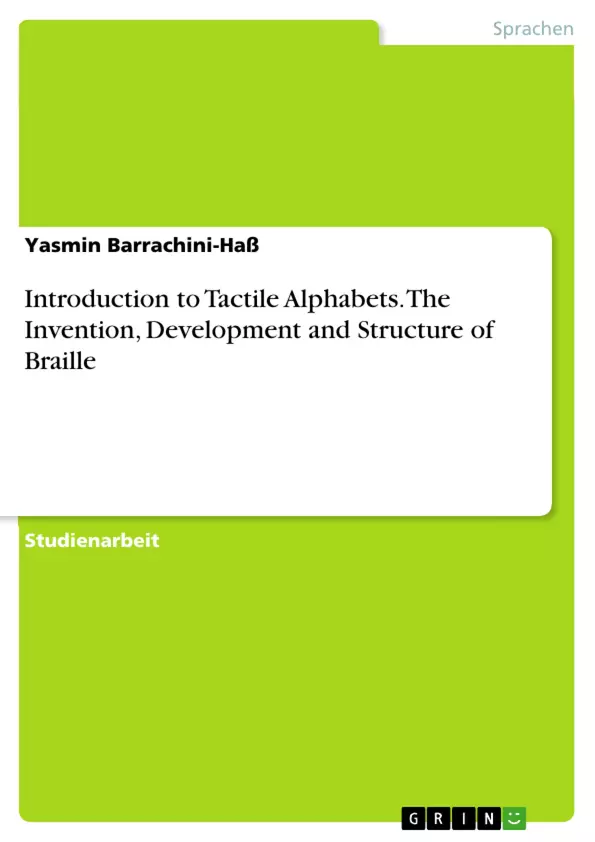This term paper focuses mainly on the characteristics of Braille which are relevant from a linguistic point of view, but also discusses historical events of how Louis Braille invented the aforesaid writing system, as well as how the aforesaid writing system evolved over the past 187 years. It must also be said that this term paper focuses mainly on American English Braille (AEB), because this particular writing system is widely used, well documented, and has evolved faster than any other tactile writing system. However, other types of Braille are occasionally mentioned in this paper, too.
Braille is a writing system that is mostly used by blind people or people who suffer from significant vision loss. However, individuals who are not visually impaired can also read it by using their eyesight. A special feature about Braille is that it can be read by using just one’s finger tips.
The first chapter deals with tactile alphabets in general. Since Braille is just one type of many existing tactile alphabets, this chapter clarifies its definition and variations. There are two different types of tactile alphabets. One is based on embossed Roman letters, and the second type of tactile alphabet is based on arbitrary symbols. Each type is further explained in a subchapter. The second chapter is about the invention and development of Braille. This chapter focuses, among other things, on the life of Braille, how he became blind and created his own writing system that evolved to be the most important reading and writing tool to many blind communities all over the world. In subchapter 2.2, it is also explained how Braille derived from an already existing tactile alphabet called night writing, and how this aforesaid writing system is structured.
The third chapter discusses linguistic features and structures of Braille. The arrangement of AEB is discussed, as well as the difference between Grade 1 Braille and Grade 2 Braille. Moreover, the third chapter discusses how Braille can be used alternatively for all other writing systems, which, among other things, do not resemble the Latin alphabet, and how that leads eventually to different variations of Braille. Finally, the Unified English Braille (UEB) code is also included as a topic in the third chapter. The aforesaid chapter is followed by a conclusion, a list of references and a declaration of authenticity.
Inhaltsverzeichnis
- Introduction
- Introduction to Tactile Alphabets
- Systems Based on Embossed Roman Letters
- Systems Based on Arbitrary Symbols
- The Invention and Development of Braille
- The Life of Louis Braille and His Revolutionary Invention
- The Origin of Braille: Night Writing
- The Structure of Braille
- The Structure of American English Braille
- The Difference between Grade 1 Braille and Grade 2 Braille
- Braille Variations: How to Deal with Different Language Structures?
- Unified English Braille Code
- Conclusion
Zielsetzung und Themenschwerpunkte
Diese Arbeit befasst sich mit der Geschichte und den linguistischen Eigenschaften der Brailleschrift, insbesondere der amerikanischen englischen Brailleschrift (AEB). Der Schwerpunkt liegt auf der Entstehung, Entwicklung und Struktur dieser taktilen Schriftsprache.
- Die verschiedenen Arten von taktilen Schriftsystemen
- Die Geschichte der Erfindung und Entwicklung der Brailleschrift
- Die Struktur der amerikanischen englischen Brailleschrift
- Die Unterschiede zwischen Grade 1 und Grade 2 Brailleschrift
- Braille-Variationen für verschiedene Sprachen und Schriftsysteme
Zusammenfassung der Kapitel
Das erste Kapitel gibt einen Überblick über verschiedene taktile Schriftsysteme, insbesondere solche, die auf dem lateinischen Alphabet basieren. Es werden die beiden Haupttypen, geprägt mit römischen Buchstaben und basierend auf arbiträren Symbolen, vorgestellt.
Das zweite Kapitel befasst sich mit der Geschichte der Brailleschrift. Es enthält Informationen über das Leben von Louis Braille, seine Erfindung und die Entwicklung des Schriftsystems aus dem "Nacht-Schreiben".
Das dritte Kapitel analysiert die linguistischen Strukturen der Brailleschrift. Es behandelt die Struktur der amerikanischen englischen Brailleschrift, die Unterschiede zwischen Grade 1 und Grade 2 Braille sowie die Anpassung der Brailleschrift an verschiedene Sprachen und Schriftsysteme. Dieses Kapitel beleuchtet auch den Unified English Braille (UEB) Code.
Schlüsselwörter
Taktile Schriftsysteme, Brailleschrift, amerikanische englische Brailleschrift (AEB), Louis Braille, Nacht-Schreiben, Grade 1 Braille, Grade 2 Braille, Unified English Braille (UEB), linguistische Strukturen, Schriftsystem, Sprachvariationen.
- Arbeit zitieren
- Yasmin Barrachini-Haß (Autor:in), 2012, Introduction to Tactile Alphabets. The Invention, Development and Structure of Braille, München, GRIN Verlag, https://www.grin.com/document/320533



